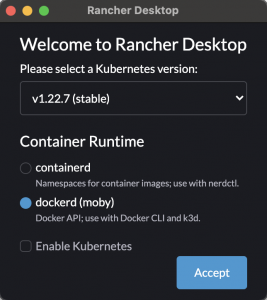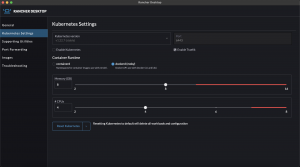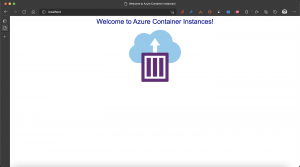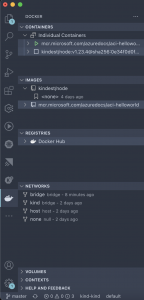Last year I wrote a blog post about running Podman on macOS with Multipass as a Docker Desktop replacement.
-> https://www.danielstechblog.io/running-podman-on-macos-with-multipass/
Back at that time I had looked also into Podman Machine and Rancher Desktop. Podman Machine was out very quickly without support for host volume mounts. Rancher Desktop instead was promising but the host volume mount performance was not that what I am used to, and you could not disable the Kubernetes component.
Since Rancher Desktop version 1.1.0, which has been released a couple of days ago, you can finally disable the Kubernetes component just using containerd or dockerd as your container runtime. Also, the host volume mount performance is now as good what Docker Desktop provides.
-> https://github.com/rancher-sandbox/rancher-desktop/releases/tag/v1.1.0
Kubernetes can be disabled to run just containerd or dockerd by itself for reduced resource consumption.
So, here we are again talking about how to replace Docker Desktop on macOS with Rancher Desktop.
Rancher Desktop
When you have installed Rancher Desktop and start it for the first time you are greeted by the initial configuration screen.
As I do not want to use the built-in Kubernetes component of Rancher Desktop, I uncheck it and switching the container runtime from containerd to dockerd.
The reason I am disabling the built-in Kubernetes component is the following that I am using KinD (Kubernetes in Docker) as my local Kubernetes setup providing a near identical setup locally what I am using in Azure with AKS. KinD offers a lot of customization like using another CNI component like Calico for CNI and network policies instead of relying on the built-in one. But this is a matter of taste, and you might be happy with the built-in Kubernetes component k3s of Rancher Desktop.
Rancher Desktop uses per default 2 CPUs and 4 GB memory which I adjusted to 4 CPUs and 8 GB memory. Those changes are applied by hitting the button Reset Kubernetes which in the end restarts Rancher Desktop.
Before we start with a quick check of Rancher Desktop let me tell you something about the default host volume mounts Rancher Desktop provides. Per default your home folder and the folder /tmp/rancher-desktop are available for mounting them into your containers.
Now let us do the quick check. I am spinning up the ACI hello world container image from Microsoft and map the port to port 80.
> docker run -d -p 80:80 mcr.microsoft.com/azuredocs/aci-helloworld:latest > docker ps CONTAINER ID IMAGE COMMAND CREATED STATUS PORTS NAMES c6cad07051b9 mcr.microsoft.com/azuredocs/aci-helloworld:latest "/bin/sh -c 'node /u…" 16 seconds ago Up 14 seconds 0.0.0.0:80->80/tcp, :::80->80/tcp clever_goldberg
Like Docker Desktop the ACI hello world container can be reached via localhost.
If you want to use KinD as well on Rancher Desktop for Kubernetes, make sure you use the latest release v0.12.0.
-> https://github.com/kubernetes-sigs/kind/releases/tag/v0.12.0
I had not any success to spin up KinD with the version before on Rancher Desktop.
> docker ps CONTAINER ID IMAGE COMMAND CREATED STATUS PORTS NAMES f9dab90645b0 kindest/node:v1.23.4 "/usr/local/bin/entr…" 47 hours ago Up 53 seconds 127.0.0.1:6443->6443/tcp, 127.0.0.1:80->30000/tcp, 127.0.0.1:443->30001/tcp, 127.0.0.1:15021->30002/tcp kind-control-plane > kubectl get nodes -o wide NAME STATUS ROLES AGE VERSION INTERNAL-IP EXTERNAL-IP OS-IMAGE KERNEL-VERSION CONTAINER-RUNTIME kind-control-plane Ready control-plane,master 47h v1.23.4 172.18.0.2 <none> Ubuntu 21.10 5.10.93-0-virt containerd://1.5.10 > kubectl get pods -n kube-system NAME READY STATUS RESTARTS AGE azure-policy-86bcfd97bf-n82kr 1/1 Running 4 (75s ago) 46h azure-policy-webhook-559c5b7cb9-tlv96 1/1 Running 4 (75s ago) 46h coredns-64897985d-b6z7p 1/1 Running 2 (75s ago) 47h coredns-64897985d-jkblr 1/1 Running 2 (75s ago) 47h etcd-kind-control-plane 1/1 Running 2 (75s ago) 47h kube-apiserver-kind-control-plane 1/1 Running 2 (75s ago) 47h kube-controller-manager-kind-control-plane 1/1 Running 5 (75s ago) 47h kube-proxy-r8f9f 1/1 Running 2 (75s ago) 47h kube-scheduler-kind-control-plane 1/1 Running 5 (75s ago) 47h metrics-server-865ff485bf-gkxwl 1/1 Running 5 (75s ago) 47h
Summary
When you are looking for a real drop-in replacement of Docker Desktop on macOS, Rancher Desktop got you covered. As Rancher Desktop provides dockerd as runtime beside containerd all commands like docker and docker-compose continue to work out of the box. Also, Visual Studio Code immediately recognizes Rancher Desktop when you use dockerd as container runtime.



